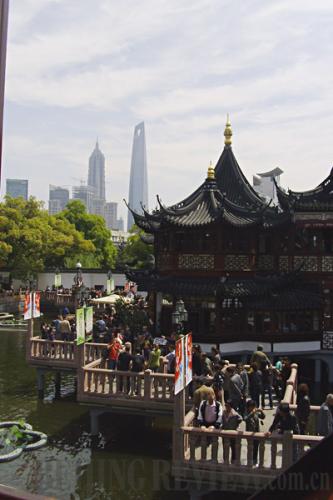|
 |
|
OLD AND NEW: Skyscrapers rise in the distance through a window at the historic Yu Garden (BRANDON TAYLOR) |
Having lived in Beijing for almost a year, and only visiting neighboring Tianjin and Xi'an in Shaanxi Province, I've grown accustomed to cities shorter in stature—those rich in history and culture but lacking the skyscrapers and other structural symbols of a modern metropolis found in cities stateside.
A week before the World Expo 2010 I was sent to Shanghai on business and witnessed another side of China I had yet to see.
The slightest mention of the city's name conjures images of a Chinese cityscape vast in size, modern and typical of most American cities. And although I'd never visited the city before, Shanghai was far less foreign to me than my initial Chinese ventures to Xi'an or even Beijing.
I'd heard Shanghai compared to New York City due to the similarities between the two cities' tall skylines. Shanghai was growing as a major financial hub for China and the rest of Asia—I'd even heard of an "Oriental Wall Street" somewhere in Shanghai. Then there was the hint of something Western almost everywhere I went—the Bund, Pudong, and most of the night spots frequented by foreigners. But as impressed as I was by the commercial center, I have to admit, it was no New York City—it was something different, something better.
My tour of Shanghai took me from the aged Waibaidu Bridge and Bund area to the top of the Shanghai World Financial Center 492 meters off the ground in prosperous Pudong; from the tiny, quiet corridors of the Tianzifang art alley to lively and trendy Xintiandi.
But the highpoint of my trip wasn't the bright lights of Shanghai's entertainment scene or looking out across Shanghai from an observation platform on the tallest building in China—it was a photo I took while having lunch at Chenghuang Temple that so amazed me. Through a window, I could see winding bridges and ancient temple structures—remnants of Shanghai's past—while in the distance stood the Jin Mao Tower and Shanghai World Financial Center, two monoliths of the modern era.
This blend of ancient and modern made me realize what a diverse and dynamic city Shanghai is—a place actively embracing its past while striving to reach its fullest potential in an increasingly modernizing world.
But perhaps more important than Shanghai's appearance is Shanghai's populace.
The theme for the 2010 World Expo, "Better City, Better Life," could not more appropriately describe Shanghai. As the largest city in China and the most populous city in the world, Shanghai faces the challenge of providing for a population that can only be described as massive—20 million in the city proper, by some estimates.
While walking down Nanjing Road, basking in the glow of department store lights, I was fascinated by the river of people flowing up and down the shopping epicenter of Shanghai. These were the lives that would be made "better"—the less fortunate people picking through the trash for a few empty bottles, but also the people carrying shopping bags from upscale stores. For the poor, a better life will mean some sort of social welfare. For those with a sustainable income, a better life will mean addressing environmental concerns and everyday city-related issues.
And Shanghai, as the largest city in a developing country, can serve as an example for other Chinese cities and major urban centers worldwide to follow to advance and accommodate their growing populations—United Nations figures show the urban population now accounts for 55 percent of the total world population. Be it social or environmental issues, Shanghai must be ready to meet these demands by becoming a better city to provide a better life for its people.
If anything, the Expo could inspire healthy changes within Shanghai's economic and social landscape. Masaaki Kanda—governor of Aichi, Japan, site of the 2005 World Expo—says a World Expo "can bring lasting benefits to its host, both from the standpoint of the economy and also from the enrichment of people's lives," describing the improvement in environmental awareness, introduction of new recycling measures and economic benefits from Aichi's international airport that came to fruition after the Japanese city's Expo.
This is where the real benefits will be seen–not before or during the Expo, but in the months and years following. While large populations—and in China's case, overpopulation–pose challenges to development and modernization efforts, Shanghai can use the Expo as a starting point to spur its bustling population into embracing environmentally-friendly lifestyles and the green economy.
In preparation for the world event, infrastructure improvements were made to accommodate the expected influx of visitors and various efforts taken to improve the city's image. A concrete promenade now allows sightseers to enjoy the architectural marvels of the Bund, the beauty of the Huangpu River and the behemoth skyscrapers in Pudong. But what will Shanghai look like a year or two after the Expo? Will it be better? That will be the true test–to see if creating a better city and better life is an actual possibility or a mere dream.
Full of energy and life, Shanghai is already a spectacular place. The World Expo will allow Shanghai to show the world it is more than just tall buildings, Western-influenced architecture and historic landmarks. It is people waiting for change and willing to participate for a better life.
The author is an American living in Beijing |